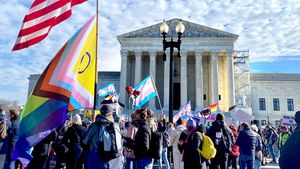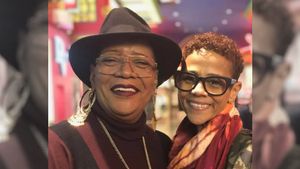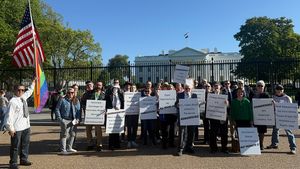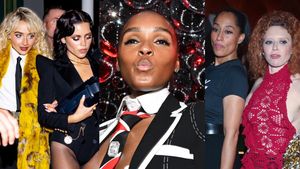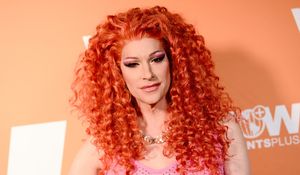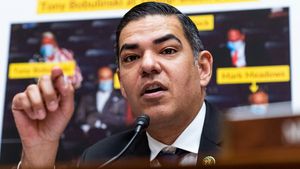Photography by Andy Ryan
Edie Windsor met Thea Spyer in a distant New York City, before Stonewall, long before AIDS. It was 1965; the Beatles were singing 'Yesterday,' and Bewitched was in its first season. They met, and they danced, and they fell in love. They were both professional women -- Thea was a clinical psychologist with a practice in New York; Edie spent much of her life as a computer systems consultant for IBM. In 1975, Thea was diagnosed with multiple sclerosis, which advanced rapidly until she could no longer walk, though she continued practicing throughout her life. The couple married in Toronto in 2007, but Thea's death in 2009 resulted in a $350,000 penalty in federal estate taxes that would have been avoided if they were a heterosexual couple. Last November, Edie -- who was recently the subject of a documentary, Edie & Thea: A Very Long Engagement -- filed a lawsuit, with the aid of the ACLU, challenging the constitutionality of the Defense of Marriage Act, which defines marriage as a legal union between one man and one woman as husband and wife. Here she recalls her 44-year relationship.
I had crushes on girls in my early life, but I mostly dated guys. I married a guy I adored at college, but I was jealous if I saw two women out together. And finally, after less than a year, I said, 'Honey, this is wrong. You deserve more and I need something else.' We didn't talk again until my 70th birthday when he called to say, 'I still love you.' And that was great. My mother never discussed sex with me, but when I told her I was getting a divorce, she said, 'How is the sex?' And I said, 'It's not.' And she said, 'Then there's nothing to hold you there.' That was all. If my parents had known the truth, would they have stopped loving me? I don't think so. Ultimately when they met Thea, it was perfectly obvious that we were together.
I remember reading a little lesbian paperback about a schoolteacher who came to New York for the summer, and she looks in the mirror, and she's all dressed up, and she says, 'You're in New York, where anything can happen.' Then she says, 'Oh, come on, what could happen?' And finally, she says to herself, 'I could kiss a woman.' And I read that, and I said, 'Where!?' I couldn't imagine how you found them. Once, when I came in from Philadelphia for a wedding, I stopped a woman wearing a trench coat and a pink button-down shirt, and I asked if there was a woman's bar around, and she directed me to what was Elle's Bar at the time. So I went to this bar, and I was dressed to the teeth -- and no one was dressed to the teeth -- and I sat there at the bar nursing my drink, but no one talked to me! And that was it. I went back to my hotel. That was my first New York bar experience.
I came to New York to be a lesbian when I divorced. Near Downing Street there was a bar called the Laurels. I went maybe twice a week, and I got to know people, and I never paid for a drink myself. I always ended up with more money on the table than I started with. I would get little notes from girls the next day saying, 'Forget the others,' but I felt most strongly that with a woman you don't touch her until you can't bear not to. I spent a lot of time in that bar. There was a night when it was empty and silent, and I sat there for maybe half an hour, and I thought, There's going to be a raid. Turned out it was Election Day.
I met Thea at the Portofino, a restaurant in the West Village. There was a place near it called the Bagatelle, over on University Place, and I used to go to there five nights a week. I would read the Saturday Review of Literature; I would have my coffee there -- me and a bunch of buddies. I thought she was sensational, and mostly she was a great dancer. And we really danced. And then we met over the next two years. We always danced together. But it wouldn't have occurred to me to make any moves on someone who was with someone. And she was always with someone. And then one summer she was not with someone. I knew she had a place in the Hamptons, so I wrangled an invitation through a friend. I was wild for her. I don't know how to describe it. It was everything. It was just more so. We were profoundly in love and stayed that way. Many, many years later, I said to her, 'When did you really start to deeply love me?' And she said, 'Mrs. Fordham's house,' which is the house we rented one summer in the Hamptons. We had very different passions, but we both had enormous love for each other's passions. She played the violin. She played golf. And she did them both obsessively. With golf I had to make certain rules, because if she came home talking her head off about every shot, I would say, 'The idea is for you to go and enjoy it and discuss it completely and then come home.'
Thea was diagnosed with MS the day before my mother died. That was in 1975, and by 1980 she was using two Canadian crutches. The first time we ever danced using the wheelchair -- I would sit in her lap in the wheelchair -- the song on the radio was, 'There's a place for us, there's a time for us.' I can't even sing it because I cry. When I'm sick now -- I have a lot of angina -- that's when I miss her the most. I say to myself, 'Honey, what's become of us?' And I lean against the full-length picture that I have of her. But she had this angina increasingly, and the doctor had said, 'If you can last for two more years, they're very close to having this noninvasive blah, blah, blah,' but it was clear that she wasn't going to survive open-heart surgery to get to the valve. And she said, 'We only have two years at best that they could give me.' And one of those years would be lying in a hospital, and she just said, 'No. I want the summer.' She said, 'I'm not coming to the hospital.' I made her get on the phone so the doctor would know, and asked if there was anything else we could do, and he said, 'Nothing -- give her a little morphine.' And she elected it. That's one of the greatest things, the part of the picture that's most meaningful to me, where she's sitting there saying, 'I had my summer.' And that was her last summer.












